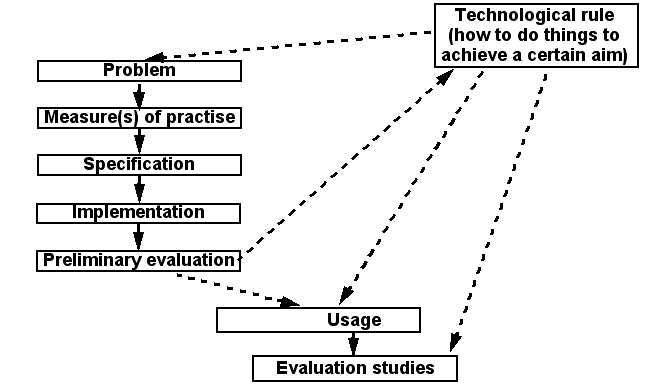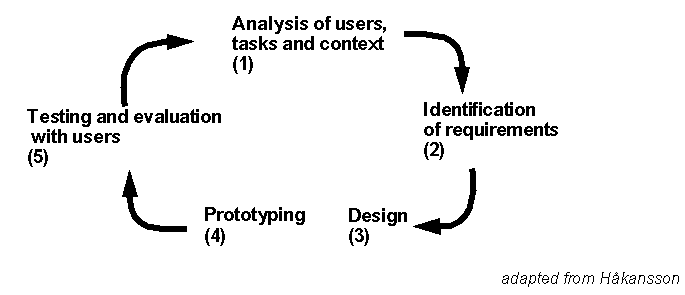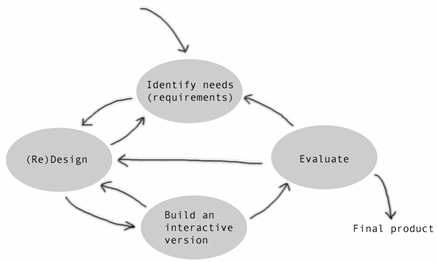Methodology tutorial - design-oriented research designs
This article or section is currently under construction
In principle, someone is working on it and there should be a better version in a not so distant future.
If you want to modify this page, please discuss it with the person working on it (see the "history")
<pageby nominor="false" comments="false"/>
Research Design for Educational Technologies - Design oriented approaches
This is part of the methodology tutorial (see its table of contents).
Note: There should be links to selected wiki articles !
Further reading: see the category for a list of design-related articles in this wiki.
Key elements of a design-oriented approach:
The global picture
Typical ingredients or steps of design research can be summarized with the following picture (Pertti Järvinen, 2004)
- The idea is to investigate at least one of the dotted lines.
- Technological rule as theory on how to things can be the research's input, output, or both.
- Technological rules
- ... tell you how to do things and are dependant on other theories (and beliefs)
- Bunge (quoted by Järvinen:99): "A technological rule: an instruction is defined as a chunk of general knowledge, linking an intervention or artifact with a desired outcome or performance in a certain field of application".
- Types of outcomes (artifacts, interventions)
- Constructs (or concept) form the " language " of a domain
- Models are sets of propositions expressing relationships among constructs
- Methods are a set of steps to perform a task (guidelines, algorithms)
- Instantiations are realizations of an artifact in its environment
- Types of research
- Build: Demonstrate feasibility of an artifact or intervention
- Evaluate: Development of criteria, and assessment of both artifact building and artifact usage
- What does this mean ?
- There are 4*2 ways to lead interesting design research.
- Usually, it’s the not the artefact (e.g. a software program) you build that is interesting, but something behind (constructs, models, methods) or around it (usage).
Examples of design rules
Below we shall present below a few examples of design rules (output of research) that are popular in educational technology. See the instructional design method article for more examples.
As you can see design (or the essence of it in terms of design rules) can be expressed in various ways:
- As concept map
- As list
- As UML diagram
The MISA instructional design method
MISA is an instructional engineering method describing graphically the instructional design processes and their products which define a learning system completely. MISA supports 35 main tasks or processes and around 150 subtasks. The method has been totally represented within the MOT knowledge editor.
A course designer works on "4 models"
- Knowledge and Skill Representation
DC: Design of Content (know-that and know-how) - Application of Teaching Methods and Approaches
DP: Design of Pedagogical specifications - Specification of Learning Materials
DM: Design of Materials - Delivery Planning
DD: Design of Delivery
Using such a method (see next slide) is worth the effort:
- if you plan do it right (e.g. buy the MOT editor)
- if you focus on a whole course instead of difficult problems
- if you plan to train yourself in instructional design
It is not clear to us what parts this model are based on research or wether it represent an engineering doctrine that aims to provide rules an educational designer should follow ...
Gagné’s 9 steps of instruction for learning
Gagné's Nine events of instruction represents a set of nine sequential rules specifying the contents of a "good" lesson (unit of learning). It is grounded in behaviorist-cognitivist theory of instruction.
- Gain attention e.g. present a good problem, a new situation, use a multimedia advertisement.
- Describe the goal : e.g. state what students will be able to accomplish and how they will be able to use the knowledge, give a demonstration if appropriate.
- Stimulate recall of prior knowledge e.g. remind the student of prior knowledge relevant to the current lesson (facts, rules, procedures or skills). Show how knowledge is connected, provide the student with a framework that helps learning and remembering. Tests can be included.
- Present the material to be learned e.g. text, graphics, simulations, figures, pictures, sound, etc. Chunk information (avoid memory overload, recall information).
- Provide guidance for learning e.g. presentation of content is different from instructions on how to learn. Use of different channel (e.g. side-boxes)
- Elicit performance "practice", let the learner do something with the newly acquired behavior, practice skills or apply knowledge. At least use MCQ’s.
- Provide informative feedback , show correctness of the trainee’s response, analyze learner’s behavior, maybe present a good (step-by-step) solution of the problem
- Assess performance test, if the lesson has been learned. Also give sometimes general progress information
- Enhance retention and transfer : inform the learner about similar problem situations, provide additional practice. Put the learner in a transfer situation. Maybe let the learner review the lesson.
Design rules from computer science
You can look at various modeling and diagram types of the Unified modeling language in order to have glance at the most popular design language in computer science with which many design problems can be modelled.
UML is a kind of qualitative data analysis tool with which various kinds of designs can be expressed. E.g. the following picture from the IMS LD Best Practice specification shows a diagram for competency-based learning with two major alternatives, advising-then-anticipating and anticipating-then-advising.

.
Read the UML activity diagram article to learn more about activity diagrams.
The design process
Modern design science is influenced by several fields, e.g. architecture or software engineering.
In educational technology research, one uses most often some kind of "agile" and iterative design method for developping software. In this wiki, we don't cover (at least at the time of writing) software design methodology very much, but some of the approaches presented below have their origin in CS.
Anyhow, most research subjects (not just software development!) can be tackled through a design science approach.
Alternatives
Pertti Järvinen (2004: 103) formulated several alternatives for the design process.
Basically, you must choose between a more top-down approach (also called the waterfall model) and a more (fully) participatory "agile" approache.
The participatory design model
Read participatory design for more information.
User-centred design:
- involves users as much as possible so that they can influence it
- integrates knowledge and expertise from other disciplines than just IT
- is highly iterative so that testing can insure that design meets users’ requirements
Participatory design does not just mean to ask users what they want and to otherwise investigate their needs, but it means that they actively will participate in all the design cycles.
A similar model from Preece, Rogers and Sharp (2002), figure also from Hakansson
Typical user analysis techniques
(Adapted from Håkansson, See the modules on qualitative data gathering and analysis)
- Questionnaires
- if user number is high
- if you know precisely what to ask (e.g. to identify user profiles, to test hypothesis gained from in-depth studies, etc.
- Semi-structured Interviews
- to explore new issues
- to let participants develop argumentation (subjective causalities)
- Focus groups
- group interview”, collecting multiple viewpoints
- Observations/Ethnography
- To observe work as it happens in its natural setting (observe task related workflow, interactions)
- to understanding context (other interactions, conditions)
- Scenarios (for task description)
- An “informal narrative description”, e.g. write real stories that describe in detail how someone will use your software (do not try to present specifications here !)
- Cultural probes
- Alternative approach to understanding users and their needs, developed by Gaver (1999)
?
Definition of requirements
Different types
- Functional requirements
- Environmental requirements
- Physical, social, organizational, technical
- User requirements
- Usability requirements
Building prototypes
- Prototypes can be anything !!
- Quote: "From paper-based storyboards to complex pieces of software: 3D paper models, cardboard mock-ups, hyperlinked screen shots, video simulations of a task, metal or plastic versions of the final product" (Håkansson).
- Prototypes are of different nature according to the stage and the evolution of the
design process:
- Useful aid when discussing ideas (e.g. you only need a story-board here)
- Useful for clarifying vague requirements (e.g. you only need some UI interface mockup)
- Useful for testing with users (e.g. you only need partial functionality of the
implementation)
Design-based research
Evaluation
Evaluation criteria
- Evaluation usually happens according to some "technological rule"
Example: Merril’s criteria for 5 Star Instructional Design’s
Not applicable to transmissive (“spray-and-pray” / or exploratory designs (“sink-or swim”).
- Does the courseware relate to real world problems?
... show learners the task or the problem they will be able to do/solve ?
are students engaged at problem or task level not just operation or action levels?
... involve a progression of problems rather than a single problem?
- Does the courseware activate prior knowledge or experience?
do learners have to recall, relate, describe, or apply knowledge from past experience (as a foundation for new knowledge) ?
does the same apply to the present courseware ?
is there an opportunity to demonstrate previously acquired knowledge or skill ?
- Does the courseware demonstrate what is to be learned ?
Are examples consistent with the content being taught? E.g. examples and non-examples for concepts, demonstrations for procedures, visualizations for processes, modeling for behavior?
Are learner guidance techniques employed? (1) Learners are directed to relevant information?, (2) Multiple representations are used for the demonstrations?, (3) Multiple demonstrations are explicitly compared?
Is media relevant to the content and used to enhance learning?
- Can learners practice and apply acquired knowledge or skill?
Are the application (practice) and the post test consistent with the stated or implied objectives ? (1) Information-about practice requires learners to recall or recognize information. (2) Parts-of practice requires the learners to locate, name, and/or describe each part. (3) Kinds-of practice requires learners to identify new examples of each kind. (4) How-to practice requires learners to do the procedure. (5) What-happens practice requires learners to predict a consequence of a process given conditions, or to find faulted conditions given an unexpected consequence.
Does the courseware require learners to use new knowledge or skill to solve a varied sequence of problems and do learners receive corrective feedback on their performance?
In most application or practice activities, are learners able to access context sensitive help or guidance when having difficulty with the instructional materials? Is this coaching gradually diminished as the instruction progresses?
- Are learners encouraged to integrate (transfer) the new knowledge or skill into their
everyday life?
Is there an opportunity to publicly demonstrate their new knowledge or skill?
Is there an opportunity to reflect-on, discuss, and defend new knowledge or skill?
Is there an opportunity to create, invent, or explore new and personal ways to use new knowledge or skill?
=> This is rather a list of evaluation criteria
let’s now look at learning types and instructional methods before we look a design method
Evaluation methodology
Design evaluation methodology draws all major social science approaches,
e.g. Håkansson cites:
- Heuristics
- Experiments
- Questionnaires
- Interviews
- Observations
- Think-aloud
Therefore:
- have a look at my others slides :)
Nielsons (1993) usability methods
http://fdlwww.kub.nl/~krahmer/evaluation-introduction.ppt
File:Book-research-design-173.png
Examples
V. Synteta’s master thesis
Title: EVA_pm: Design and Development of a Scaffolding Environment For Students Projects
Objectives (quotations from the thesis,
- This study is also an intervention for improving PBL efficiency. It entails the
development of a Scaffolding Learning Environment (SLE1) that is trying to learn from the lessons of the past and leverage from stresses on new technologies like XML2 and the World Wide Web making a lightweight and easily portable environment.
- Most of the research for improving PBL efficiency tries to remediate specific weaknesses
of PBL, but doesn’t propose a complete system that supports a substantial student project through all it’s phases and for all contexts.
- Our key goal was to develop a constructivist environment and a method for scaffolding
students’ projects (assignments) from their management up to the writing of their final report.
So, the objectives of this SLE are:
- to help students develop scientific inquiry and knowledge integration skills, to focus
on important and investigate key issues;
- to support them directing investigations;
- to make students better manage the time and respect the time constraints;
- to overcome possible writer’s block, or even better to avoid it;
- to help students acquire knowledge on project design and research skills;
- to improve team management and collaboration (especially collaborative editing of
student groups);
- to make students reflect on their work;
- to support the tutor’s role in a PBL approach;
- to facilitate monitoring and evaluation for the tutor;
- to help the tutor verify whether knowledge is being acquired;
- to motivate the peers, and eventually to distribute the results to bigger audiences.
Research questions: see above
Method
- Field exploration:
- A very important part of this research was to conceive a grammar that would model the
work of an academic project. There are different sources of information that have been used to achieve this goal. (....)
- Survey of needs with a questionnaire:
- In order to gather precious information from the key persons involved in projects, like
professors and their assistants, a questionnaire was articulated in such a way that would provoke a productive discussion, leading to comments and suggestions that would improve this research. The idea was to give the questionnaire to a small sample of the unit and stop the survey when the same answers came up again.
- The development method
- ... that has been adopted corresponds to participatory design and specifically to
cooperative prototyping .
- Both "prototyping" and "user involvement" (or "user centered design") are concepts that
have frequently been suggested to address central problems within system development in recent years. The problems faced in many projects reduce to the fact that the systems being developed do not meet the needs of users and their organizations. [...]
Traditional Information System prototyping approaches (after Grønbæk, 1991).
File:Book-research-design-174.png
Cooperative prototype approach used in this study (after Grønbæk, 1991)
File:Book-research-design-175.png
F. Radeff’s master thesis
Title: Le portail personnalisable comme interface d'optimisation de ressources académiques
Research questions
La question principale de ce travail est : pourquoi les bibliothèques universitaires ne proposent-elles pas de portails personnalisables, ces derniers constituant vraisemblablement une bonne solution pour l'optisation des ressources des bibliothèques à l'ère numérique.
Cette question peut s'articuler en 3 sous-questions :
• pourquoi pas plus de portails personnalisables ?
• pourquoi les gens ne personnalisent-ils pas ?
• la personnalisation correspond-elle à un besoin ?
Method, not clearly articulated, e.g.:
- La méthodologie retenue est une revue de la littérature, afin d'expliciter les concepts,
de dégager les grands modèles et d'examiner les dispositifs existants, accompagnée d'un monitoring sur l' implémentation partielle d'un prototype de dispositif de portail personnalisable.
- L'implémentation partielle n'ayant pu être menée à terme, le monitoring a été supprimé
et j'ai élargi le champ de la revue de littérature. L'analyse est donc qualitative, les données quantitatives initialement prévues n'ayant pu être collectées.
- Le matériel recueilli lors du prototype MyBCU ainsi que l'expérience acquise en
2001-2002 comme webmaster [...] m'ont néanmoins permis de tenter de répondre aux questions initiales.



